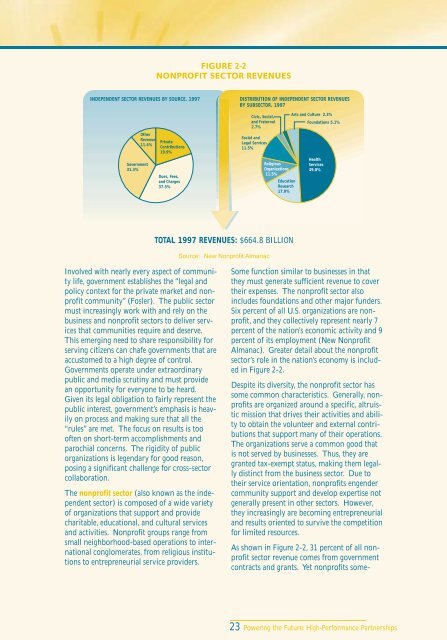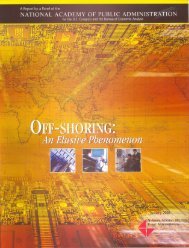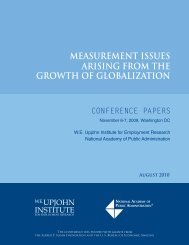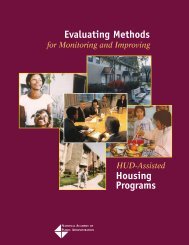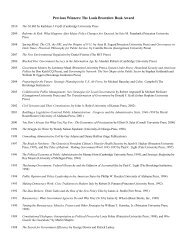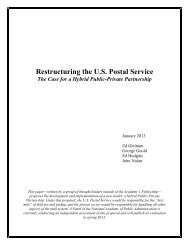High-Performance Partnerships - National Academy of Public ...
High-Performance Partnerships - National Academy of Public ...
High-Performance Partnerships - National Academy of Public ...
You also want an ePaper? Increase the reach of your titles
YUMPU automatically turns print PDFs into web optimized ePapers that Google loves.
FIGURE 2-2<br />
NONPROFIT SECTOR REVENUES<br />
INDEPENDENT SECTOR REVENUES BY SOURCE. 1997<br />
Other<br />
Revenue<br />
11.4%<br />
Government<br />
31.3%<br />
Private<br />
Contributions<br />
19.9%<br />
Dues, Fees,<br />
and Charges<br />
37.5%<br />
DISTRIBUTION OF INDEPENDENT SECTOR REVENUES<br />
BY SUBSECTOR. 1997<br />
Civic, Social,<br />
and Fraternal<br />
2.7%<br />
Social and<br />
Legal Services<br />
11.5%<br />
Religious<br />
Organizations<br />
11.5%<br />
Education<br />
Research<br />
17.9%<br />
Arts and Culture 2.3%<br />
Foundations 5.1%<br />
Health<br />
Services<br />
49.0%<br />
TOTAL 1997 REVENUES: $664.8 BILLION<br />
Source: New Nonpr<strong>of</strong>it Almanac<br />
Involved with nearly every aspect <strong>of</strong> community<br />
life, government establishes the “legal and<br />
policy context for the private market and nonpr<strong>of</strong>it<br />
community” (Fosler). The public sector<br />
must increasingly work with and rely on the<br />
business and nonpr<strong>of</strong>it sectors to deliver services<br />
that communities require and deserve.<br />
This emerging need to share responsibility for<br />
serving citizens can chafe governments that are<br />
accustomed to a high degree <strong>of</strong> control.<br />
Governments operate under extraordinary<br />
public and media scrutiny and must provide<br />
an opportunity for everyone to be heard.<br />
Given its legal obligation to fairly represent the<br />
public interest, government’s emphasis is heavily<br />
on process and making sure that all the<br />
“rules” are met. The focus on results is too<br />
<strong>of</strong>ten on short-term accomplishments and<br />
parochial concerns. The rigidity <strong>of</strong> public<br />
organizations is legendary for good reason,<br />
posing a significant challenge for cross-sector<br />
collaboration.<br />
The nonpr<strong>of</strong>it sector (also known as the independent<br />
sector) is composed <strong>of</strong> a wide variety<br />
<strong>of</strong> organizations that support and provide<br />
charitable, educational, and cultural services<br />
and activities. Nonpr<strong>of</strong>it groups range from<br />
small neighborhood-based operations to international<br />
conglomerates, from religious institutions<br />
to entrepreneurial service providers.<br />
Some function similar to businesses in that<br />
they must generate sufficient revenue to cover<br />
their expenses. The nonpr<strong>of</strong>it sector also<br />
includes foundations and other major funders.<br />
Six percent <strong>of</strong> all U.S. organizations are nonpr<strong>of</strong>it,<br />
and they collectively represent nearly 7<br />
percent <strong>of</strong> the nation’s economic activity and 9<br />
percent <strong>of</strong> its employment (New Nonpr<strong>of</strong>it<br />
Almanac). Greater detail about the nonpr<strong>of</strong>it<br />
sector’s role in the nation’s economy is included<br />
in Figure 2-2.<br />
Despite its diversity, the nonpr<strong>of</strong>it sector has<br />
some common characteristics. Generally, nonpr<strong>of</strong>its<br />
are organized around a specific, altruistic<br />
mission that drives their activities and ability<br />
to obtain the volunteer and external contributions<br />
that support many <strong>of</strong> their operations.<br />
The organizations serve a common good that<br />
is not served by businesses. Thus, they are<br />
granted tax-exempt status, making them legally<br />
distinct from the business sector. Due to<br />
their service orientation, nonpr<strong>of</strong>its engender<br />
community support and develop expertise not<br />
generally present in other sectors. However,<br />
they increasingly are becoming entrepreneurial<br />
and results oriented to survive the competition<br />
for limited resources.<br />
As shown in Figure 2-2, 31 percent <strong>of</strong> all nonpr<strong>of</strong>it<br />
sector revenue comes from government<br />
contracts and grants. Yet nonpr<strong>of</strong>its some-<br />
23 Powering the Future: <strong>High</strong>-<strong>Performance</strong> <strong>Partnerships</strong>


